17.1: Promotion
17.1.1: Word of Mouth
To promote and manage word-of-mouth communications, marketers use publicity techniques to achieve desired behavioral response.
Learning Objective
Explain how marketers effectively use word-of-mouth
Key Points
- Word of mouth, or viva voce, is the passing of information from person to person by oral communication.
- Word-of-mouth marketing including buzz, blog, viral, grassroots, brand advocates, cause influencers, and social media marketing, as well as ambassador programs, work with consumer-generated media and more, can be highly valued by product, social media and performance marketers.
- To promote and manage word-of-mouth communications, marketers use publicity techniques as well as viral marketing methods to achieve desired behavioral response.
Key Terms
- viral marketing
-
the use pre-existing social networks and other technologies to produce increases in brand awareness or to achieve other objectives (such as product sales) through self-replicating processes
- marketing
-
The promotion, distribution and selling of a product or service; includes market research and advertising.
Word of mouth, or viva voce, is the passing of information from person to person by oral communication. Storytelling is the oldest form of word-of-mouth communication where one person tells others of something, whether a real event or something made up. Another important form of word of mouth is oral history—the recording, preservation, and interpretation of historical information, based on the personal experiences and opinions of the speaker. Oral history preservation is the field that deals with the care and upkeep of oral history materials collected by word of mouth, whatever format they may be in. An important area of marketing is called word-of-mouth marketing, which relies on the added credibility of person-to-person communication.
Word-of-mouth marketing, which encompasses a variety of subcategories, including buzz, blog, viral, grassroots, brand advocates, cause influencers, and social media marketing, as well as ambassador programs, work with consumer-generated media. Because of the personal nature of the communications between individuals, it is believed that product information communicated in this way has an added layer of credibility. Research points to individuals being more inclined to believe word-of-mouth marketing more than formal forms of promotion methods; the receiver of word-of-mouth referrals tends to believe that the communicator is speaking honestly and is unlikely to have an ulterior motive (i.e. they are not receiving an incentive for their referrals). Word-of-mouth depends on the extent of customer satisfaction with the product or service and on the degree of its perceived value.
To promote and manage word-of-mouth communications, marketers use publicity techniques as well as viral marketing methods to achieve desired behavioral response. Companies can focus on brand advocates, the people who proactively recommend their favorite brands and products online and offline without being paid to do so. Influencer marketing is also increasingly used to seed WOMM by targeting key individuals that have authority and a high number of personal connections.
Marketers place significant value on positive word-of-mouth, which is traditionally achieved by creating products, services, and customer experiences that generate conversation-worthy “buzz” naturally. The relatively new practice of word-of-mouth marketing attempts to inject positive “buzz” into conversations directly. While marketers have always hoped to achieve positive word-of-mouth, intentional marketing relying on such techniques is legislated in some jurisdictions. For example, in the United States, deliberate efforts to generate beneficial consumer conversations must be transparent and honestly conducted in order to meet the requirements of Section 5 of the Federal Trade Commission Act that prohibits “unfair or deceptive acts or practices. ” To help marketers understand the difference between legitimate and unfair practices, a number of professional organizations have put forward recommendations for ethical conduct.
17.1.2: Digital Marketing
Digital marketing is the use of internet connected devices to engage a customer with online advertising to promote products and services.
Learning Objective
Break down digital marketing into push and pull strategies
Key Points
- Internet marketing, also known as web marketing, online marketing, webvertising, or e-marketing, is referred to as the marketing (generally promotion) of products or services over the Internet.
- Internet marketing ties together the creative and technical aspects of the Internet, including design, development, advertising and sales.
- Websites, blogs and streaming media (audio and video) are also examples of pull digital marketing. Articles with specific target / topic are a great source to pull interested viewers.
Key Term
- customer relationship management
-
Customer relationship management (CRM) is a widely implemented model for managing a company’s interactions with customers, clients and sales prospects.
Internet marketing, also known as web marketing, online marketing, webvertising, or e-marketing, is referred to as the marketing (generally promotion) of products or services over the Internet. Internet marketing is considered to be broad in scope because it not only refers to marketing on the Internet but also includes marketing done via e-mail and wireless media. Digital customer data and electronic customer relationship management (ECRM) systems are also often grouped together under internet marketing.
Internet marketing ties together the creative and technical aspects of the Internet, including design, development, advertising, and sales. Internet marketing also refers to the placement of media along many different stages of the customer engagement cycle through search engine marketing (SEM), search engine optimization (SEO), banner ads on specific websites, email marketing, mobile advertising, and Web 2.0 strategies.
In 2008, The New York Times, working with comScore, published an initial estimate to quantify the user data collected by large Internet-based companies. Counting four types of interactions with company websites in addition to the hits from advertisements served from advertising networks, the authors found that the potential for collecting data was up to 2,500 times per user per month.
Digital marketing is the use of internet-connected devices to engage a customer with online advertising in order to promote products and services. Internet-connected devices are those such as web browsers, smart phones, and game consoles. As technology develops, more devices become capable of internet browsing and the digital marketing potential that comes with it.
Pull digital marketing is marketing in which the consumer must actively seek content—often via web searches or arrangements in which the recipient has been given permission to receive content that is sent to the consumer by email, text message, or web feed. Websites, blogs, and streaming media (audio and video) are also examples of pull digital marketing. Articles with specific target / topic are a great source to pull interested viewers. In each of these, users have to link to the website to view the content. Only current web browser technology is required to maintain static content. However, additional internet marketing technologies (search engine optimization) may be required to attract the desired consumer demographic. Research by Martin et al. (2003) found what permission email marketing content consumers find useful, such as special sales and new product information, whereas suggesting interesting hyperlinks was not seen as useful.
Push digital marketing involves a marketer sending a message without the consent of the recipients, such as display advertising on websites and news blogs. Email, text messaging, and web feeds can also be classed as push digital marketing when the recipient has not given permission for the marketer to send the marketing message. (This is also known as spam. ) Push technologies can deliver content as soon as it becomes available and are better targeted to their consumer demographics, although audiences are often smaller, and the costs of creation and distribution are higher. Push digital marketing technologies are more proper when done with prior permission—a concept called permission marketing. This is also more ethical. Permission can be obtained through subscriptions, consent to send email, etc.
Push and pull message technologies can be used in conjunction with each other. For example, an email campaign can include a banner ad or link to a content download. This enables a marketer to benefit from both types of digital marketing .
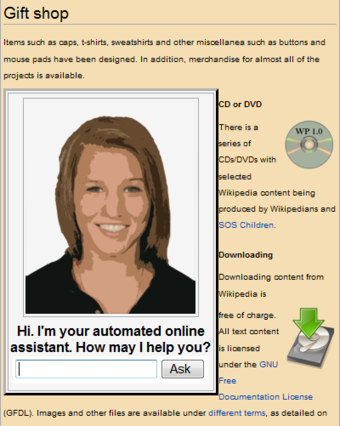
Automated online assistant
An example of E-leadership
17.1.3: Sampling
Sampling involves providing a sample of a consumer product to consumers so that they may try said product before committing to a purchase.
Learning Objective
Explain how sampling turns individuals into customers
Key Points
- The purpose of a free sample is to acquaint the consumer with a new product, and is similar to the concept of a test drive, in that a customer is able to try out a product before purchasing it.
- While placement and word of mouth impact future purchases, sampling can create an almost immediate impulse purchase.
- The success of a sampling program for a new product introduction is dependent on sound planning of overall project objectives and selection of the best distribution technique, sample design, and packager.
Key Terms
- sample
-
A part of anything taken or presented for inspection, or shown as evidence of the quality of the whole; a specimen.
- freebie
-
Something which is free; a giveaway or handout.
Sampling Defined
During the product promotion process, sampling involves providing a sample of a consumer product to consumers so that they may try said product before committing to a purchase. A free sample, or freebie, is a portion of a product (i.e., food or makeup) given to consumers in retail stores or other outlets. Sometimes samples of non-perishable items are included in direct marketing mailings . The purpose of a free sample is to acquaint the consumer with a new product, and is similar to the concept of a test drive, in that a customer is able to try out a product before purchasing it.

Product Samples
Samples are either free handouts, trial sizes, or coupons for consumer products provided to consumers in the hope that they will eventually purchase the product.
Many consumer product companies now offer free samples through their websites, to encourage consumers to regularly use the products and to gather data for mailing lists of potentially interested customers. The expansion of online marketing with regards to promotional giveaways has facilitated the rise of “freebie websites” that seek to aggregate all promotional free sample offers in one place. These sites will often compile free product samples from all over the web and categorize them by type. Some product sample offers may require consumers to complete a survey or refer a friend in order to qualify for the freebies. Additionally, the advent of the “social graph” and the realization that consumers more and more take cues from each other’s reviews, has opened up a new branch of sampling called Social Sampling.
It is also possible to purchase products in small “trial size” containers. This is common with toiletries such as shampoo. Samples may also be loaned to the customer if they are too valuable to be given for free, such as samples of a countertop or of carpet to be used for remodeling.
Effectiveness of Sampling
While placement and word of mouth impact future purchases, sampling can create an almost immediate impulse purchase. According to the Product Sampling Study by Arbitron, sampling successfully reaches 70 million consumers every quarter, and one-third of customers who try a sample will buy the sampled product in the same shopping trip, and 58 percent of those surveyed reported that they would buy the product again.
Improved Product Sampling
The success of a sampling program for a new product introduction is dependent on sound planning of overall project objectives and selection of the best distribution technique, sample design, and packager. Marketers who are considering sampling their next product introduction should define the objectives of the sampling program. Procedures and timetables should be established to correspond with the sampling program, with the overall promotion of the product in mind. There are a number of popular sampling techniques:
- Coupons in pages of newspapers or magazines
- Supermarket or department store distribution
- Direct mail
- Door-to-door
- Distributing samples in public places
- Co-op gift pack programs
- and attaching samples to retail packages
The distribution technique will not be totally effective unless it is accompanied by a proper sample design, which should have maximum visual impact and identification with the full-size package.
17.1.4: Promotion Strategies
Promotion strategies differ depending on the individual business or product, but all strive to increase product demand and awareness.
Learning Objective
Identify key promotional strategies used
Key Points
- Many times with the purchase of a product there is are incentives like discounts, free items, or contests. These methods are used to increase the sales of a given product.
- Marketing strategy is a process that can allow an organization to concentrate its limited resources on the greatest opportunities to increase sales and achieve a sustainable, competitive advantage.
- Marketing strategies may differ depending on the unique situation of the individual business or product.
Key Terms
- brand
-
A name, symbol, logo, or other item used to distinguish a product, service, or its provider.
- corporate image
-
A corporate image refers to how a business is perceived. It is a generally accepted notion or image of what a company stands for.
Promotion is one of the marketing mix elements among a system of five in a promotional plan (often known as the five Ps). These elements are personal selling, advertising, sales promotion, direct marketing, and publicity. A promotional mix specifies how much attention to pay to each of the five subcategories, and how much money to budget for each. A promotional plan can have a wide range of objectives, including: sales increases, new product acceptance, creation of brand equity, positioning, competitive retaliations, or creating a corporate image. Fundamentally, however, there are three basic objectives of promotion:
- To present information to consumers as well as others
- To increase demand
- To differentiate a product from others in the marketplace
There are different ways to promote a product in different areas of media. Promoters use Internet advertisement, special events, endorsements, and newspapers or magazines to advertise their product. Many times with the purchase of a product there are incentives like discounts, free items, or contests. These methods are used to increase the sales of a given product.
Marketing strategy is a process that can allow an organization to concentrate its limited resources on the greatest opportunities to increase sales and achieve a sustainable, competitive advantage. Marketing strategy includes all basic and long-term activities in the field of marketing that deal with the analysis of the strategic situation of a company and the formulation, evaluation and selection of market-oriented strategies and therefore contribute to the goals of the company and its marketing objectives.
Marketing strategies may differ depending on the unique situation of the individual business or product. However, there are a number of ways to categorize some generic strategies.
Strategies Based on Market Dominance
In this scheme, firms are classified based on their market share or dominance of an industry. Typically there are four types of market dominance strategies:
- Leader
- Challenger
- Follower
- Nicher
Porter Generic Strategies
These strategies concentrate on the dimensions of strategic scope and strategic strength. Strategic scope refers to the market penetration while strategic strength refers to the firm’s sustainable, competitive advantage. The generic strategy framework (porter 1984) comprises two alternatives, each with two alternative scopes: Differentiation and Low-Cost Leadership, each with a dimension of focus—which can be broad or narrow. Some of these are:
- Product differentiation
- Cost leadership
- Market segmentation
- Innovation strategies
A company or product can fall into one of three categories:
- Pioneers
- Close followers
- Late followers
If the company is not a pioneer, then it must consider growth strategies. In this scheme we ask the question, “How should the firm grow? ” There are a number of different ways to answer that question, but the most common answers are:
- Horizontal integration
- Vertical integration
- Diversification
- Intensification

Marketing Metrics Continuum
The Marketing Metrics Continuum provides a framework for how to categorize metrics from the tactical to strategic. By navigating this metrics continuum, from Activity-Based to Predictive, marketers can move towards more effective marketing measurement and align measurement and metrics with business outcomes.
17.1.5: The Promotion Mix
There are five (sometimes six) main aspects of a promotional mix: Advertising, Personal selling, Sales promotion, Public relations, and Direct marketing.
Learning Objective
List the seven main aspects of the promotion mix
Key Points
- Advertising – Presentation and promotion of ideas, goods, or services by an identified sponsor.
- Personal selling – A process of helping and persuading one or more prospects to purchase a good or service or to act on any idea through the use of an oral presentation.
- Sales promotion – Media and non-media marketing communication are employed for a pre-determined, limited time to increase consumer demand, stimulate market demand or improve product availability.
- Public relations – Paid intimate stimulation of supply for a product, service, or business unit by planting significant news about it or a favorable presentation of it in the media.
- Direct Marketing is a channel-agnostic form of advertising that allows businesses and nonprofits to communicate straight to the customer.
Key Term
- Public relations
-
Public relations (PR) is the practice of managing the flow of information between an individual or an organization and the public.
There are five (sometimes six) main aspects of a promotional mix . These are:
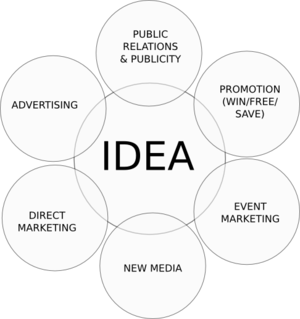
The Promotion Mix
Overview of the elements of the promotion mix.
- Advertising: Presentation and promotion of ideas, goods, or services by an identified sponsor. Examples: Print ads, radio, television, billboard, direct mail, brochures and catalogs, signs, in-store displays, posters, motion pictures, Web pages, banner ads, and emails. (Always in Paid Form non personal)
- Personal selling: A process of helping and persuading one or more prospects to purchase a good or service or to act on any idea through the use of an oral presentation. Examples: Sales presentations, sales meetings, sales training and incentive programs for intermediary salespeople, samples, and telemarketing. Can be face-to-face or via telephone.
- Sales promotion: Media and non-media marketing communication are employed for a pre-determined, limited time to increase consumer demand, stimulate market demand or improve product availability. Examples: Coupons, sweepstakes, contests, product samples, rebates, tie-ins, self-liquidating premiums, trade shows, trade-ins, and exhibitions.
- Public relations: Paid intimate stimulation of supply for a product, service, or business unit by planting significant news about it or a favorable presentation of it in the media. Examples: Newspaper and magazine articles/reports, TVs and radio presentations, charitable contributions, speeches, issue advertising, and seminars.
- Direct Marketing is a channel-agnostic form of advertising that allows businesses and nonprofits to communicate straight to the customer, with advertising techniques such as mobile messaging, email, interactive consumer websites, online display ads, fliers, catalog distribution, promotional letters, and outdoor advertising.
Corporate image may be considered as a sixth aspect of promotion mix. The Image of an organization is a crucial point in marketing. If the reputation of a company is bad, consumers are less willing to buy a product from this company as they would have been, if the company had a good image. Sponsorship is sometimes added as an seventh aspect.
New Media is also sometimes considered an element of the promotion mix.
17.1.6: A Brief Description
Promotion is one of the marketing mix elements, including personal selling, advertising, sales promotion, direct marketing, and publicity.
Learning Objective
Discuss how promotion is achieved in the 21st century
Key Points
- There are three basic objectives of promotion: To present information to consumers as well as others; to increase demand; and to differentiate a product.
- There are different ways to promote a product in different areas of media. Promoters use Internet advertising, special events, endorsements, and newspapers to advertise their products.
- Product promotion is the act of advertising goods or services with the short or long-term goal of increasing sales.
Key Term
- demand
-
The desire to purchase goods or services, coupled with the power to do so, at a particular price.
There are five components to a promotional or marketing mix (sometimes known as the Five P’s). These elements are personal selling, advertising, sales promotion, direct marketing, and publicity. A promotional mix specifies how much attention to pay to each of the five subcategories, and how much money to budget for each. A promotional plan can have a wide range of objectives, including: sales increases, new product acceptance, creation of brand equity, positioning, competitive retaliations, or creation of a corporate image. Let’s focus specifically on the promotion element of the marketing mix. There are three basic objectives of promotion and these are:
- To present information to consumers as well as others;
- To increase demand;
- To differentiate a product from other similar or competing products;
There are different ways to promote a product in different areas of media. Promoters use Internet advertisement, special events, endorsements, and newspapers or magazines to advertise their product. Many times with the purchase of a product there is an incentive like discounts, free items, or a contest. These methods are used to increase the sales of a given product.
Product promotion is the act of advertising a good or service with the short or long-term goal of increasing sales. Many companies use different techniques to promote their products through a vast array of communication mediums. In this day and age, there is not necessarily one communication medium that is better than another simply because the most effective medium depends upon on what type of product you are promoting. There is the physical form (magazines and newspapers) of product promotion and the digital form (websites and e-books), both of which require clear and concise textual information about the product being advertised.
Since the turn of the twenty-first century, many companies have been trying to utilize online social media for product promotion. Some of the most popular forms of online social media are Facebook, Twitter, and Pinterest. Within an online social media network, companies have the ability to advertise and promote their products to anyone, at any time, anywhere in the world. Because of the vast popularity and expansion of social media, companies have had great success in marketing products to the younger generation who otherwise might not see an ad in a newspaper or on TV .
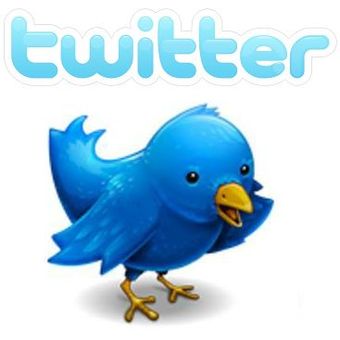
Some of the most popular forms of online social media are Facebook, Twitter, and Pinterest.
17.1.7: Promotion Objectives
Promotion is to present information to consumers to increase demand and to differentiate a product.
Learning Objective
Outline the three main objectives of promotion
Key Points
- Product promotion is the act of advertising a good or service with the short/long term goal of increasing sales.
- Since the turn of the 21st century, many companies have been trying to utilize online social media for product promotion.
- There are five market mix elements: personal selling, advertising, sales promotion, direct marketing, and publicity. A promotional plan is a marketer’s specific mix of these elements.
Key Term
- endorsements
-
In promotion and of advertising, a testimonial or show consists of a person’s written or spoken statement extolling the virtue of some product. The term “testimonial” most commonly applies to the sales-pitches attributed to ordinary citizens, whereas the word “endorsement” usually applies to pitches by celebrities. Testimonials can be part of communal marketing.
Product promotion is the act of advertising a good or service with the goal of increasing sales. Many companies use different techniques to promote their products through a vast array of communication media. In this day and age, there is not necessarily one communication medium that is better than another simply because the most effective medium is based on what type of product you are promoting. There is the physical form of product promotion and the digital form, both of which require clear and concise textual information about the product being advertised.
Since the turn of the 21st century, many companies have been trying to utilize online social media for product promotion. Some of the most popular forms of online social media are Facebook, Twitter, and MySpace. Within an online social media network, companies have the ability to advertise and promote their products to anyone, at any time, anywhere in the world. Because of the vast popularity of social media, companies have had great success on marketing products to the younger generation who otherwise might not have seen an ad in a newspaper or on TV.
Promotion is one of the five market mix elements: personal selling, advertising, sales promotion , direct marketing, and publicity. A promotional plan specifies how much attention to pay to each of the five subcategories and how much money to budget for each. A promotional plan can have a wide range of objectives, including sales increases, new product acceptance, creation of brand equity, positioning, competitive retaliations, or the creation of a corporate image. Fundamentally, however there are three basic objectives of promotion. These are to present information to consumers as well as others, to increase demand, and to differentiate a product.

Promotion
Promotion is one of the market mix elements.
There are different ways to promote a product in different media. Promoters use internet advertisement, special events, endorsements, and newspapers to advertise their product. Many times with the purchase of a product there is an incentive like discounts, free items, or a contest. This is to increase the sales of a given product.
17.2: Public Relations
17.2.1: The Purpose of Public Relations
Public relations (PR) is the practice of managing the flow of information between an individual or an organization and the public.
Learning Objective
Explain the various uses for public relations (PR)
Key Points
- A fundamental technique used in public relations is to identify the target audience, and to tailor every message to appeal to that audience.
- Lobby groups are established to influence government policy, corporate policy, or public opinion.
- Negative public relations, also called dark public relations, is a process of destroying a target’s reputation and/or corporate identity.
Key Terms
- Public relations
-
Public relations (PR) is the practice of managing the flow of information between an individual or an organization and the public.
- cognitive dissonance
-
a conflict or anxiety resulting from inconsistencies between one’s beliefs and one’s actions or other beliefs
Public Relations
Public relations, or PR, is the practice of managing the flow of information between an individual or organization and the public. Public relations provides an organization or individual exposure to their audiences using topics of public interest and news items that do not require direct payment. The aim of public relations by a company often is to persuade the public, investors, partners, employees, and other stakeholders to maintain a certain point of view about it, its leadership, products, or of political decisions. Common activities include speaking at conferences, winning industry awards, working with the press, and employee communication.
A fundamental technique used in public relations is to identify the target audience, and to tailor every message to appeal to that audience. It can be a general, nationwide, or worldwide audience, but it is more often a segment of a population. A good elevator pitch can help tailor messaging to each target audience. Marketers often refer to socio-economically driven demographics, such as “black males ages 18-49”.

Publicity
Paparazzi at work.
Stakeholder theory identifies people who have a stake in a given institution or issue. All audiences are stakeholders (or presumptive stakeholders), but not all stakeholders are audiences. For example, if a charity commissions a public relations agency to create an advertising campaign to raise money to find a cure for a disease, the charity and the people with the disease are stakeholders, but the audience is anyone who is likely to donate money.
Sometimes the interests of differing audiences and stakeholders common to a public relations effort necessitates the creation of several distinct but complementary messages. This is not always easy to do, and sometimes, especially in politics, a spokesperson or client says something to one audience that creates dissonance with another audience or group of stakeholders.
Lobby groups are established to influence government policy, corporate policy, or public opinion. Such groups claim to represent a particular interest and in fact are dedicated to doing so. When a lobby group hides its true purpose and support base, it is known as a front group. Moreover, governments may also lobby public relations firms in order to sway public opinion. A well illustrated example of this is the way civil war in Yugoslavia was portrayed. Governments of the newly seceded republics of Croatia, Bosnia, and Serbia invested heavily with British and American public relations firms to create and maintain a positive image in the United States.
Negative public relations, also called dark public relations, is a process of destroying a target’s reputation and/or corporate identity. In other words, instead of concentrating efforts in the creation and maintenance of a positive reputation or image, the objective is to discredit someone else, usually a business rival. Unlike regular services in public relations, those in negative public relations rely on the development of industries such as IT security, industrial espionage, social engineering, and competitive intelligence. A common technique is to find and reveal a dirty secret or embarrassment of the target. Dark PR can also involve twisting or producing misleading facts. An example of this is UCLA students who created a smear campaign to get people to ban dihydrogen oxide, which they said caused billions of dollars in damage yearly and killed millions. In reality, dihydrogen oxide is another name for water.
The building of a dark PR campaign, also known as a smear campaign, is a long and a complex operation. Traditionally it starts with extensive information gathering and aims to destroy the relationship between the company, its shareholders, and its customers.
Some claim that negative public relations may be highly moral and beneficial for the general public since the threat of reputation loss may be disciplining for companies, organizations, and individuals. Apart from this, negative public relations helps to expose legitimate claims against one.
17.2.2: Types of Public Relations
Public relations (PR) is the practice of managing the flow of information between an individual or an organization and the public.
Learning Objective
Explain relationship management tools used by companies
Key Points
- PR involves using technology to organize, automate, and synchronize business processes—principally sales activities, but also those for marketing, customer service, and technical support.
- Public relations provides an organization or individual exposure to their audiences using topics of public interest and news items that do not require direct payment.
- Media relations involves working with various media for the purpose of informing the public of an organization’s mission, policies and practices in a positive, consistent and credible manner.
Key Term
- stakeholders
-
Stakeholder, an entity that can be affected by the results of that in which they are said to be stakeholders, i.e., that in which they have a stake.
Public relations (PR) is the practice of managing the flow of information between an individual or an organization and the public. Public relations provides an organization or individual exposure to their audiences using topics of public interest and news items that do not require direct payment. The aim of public relations by a company often is to persuade the public, investors, partners, employees, and other stakeholders to maintain a certain point of view concerning it, its leadership, products, or political decisions. Common activities include speaking at conferences, winning industry awards, working with the press, and employee communication.
Media relations involves working with various media for the purpose of informing the public of an organization’s mission, policies, and practices in a positive, consistent, and credible manner. Typically, this means coordinating directly with the people responsible for producing the news and features in the mass media. The goal of media relations is to maximize positive coverage in the mass media without paying for it directly through advertising .

A wedding toast
The toasts that are given at a wedding are an example of special occasion speeches.
Many people use the terms public relations and media relations interchangeably; however, doing so is incorrect. “Media relations” refers to the relationship that a company or organization develops with journalists, while “public relations” is the practice of extending that relationship beyond the media to the general public.
Customer relationship management (CRM) is a widely implemented model for managing a company’s interactions with customers, clients, and sales prospects. It involves using technology to organize, automate, and synchronize business processes—principally sales activities, but also those for marketing, customer service, and technical support. The overall goals are to find, attract, and win new clients, nurture and retain those the company already has, entice former clients to return, and reduce the costs of marketing and client service. Customer relationship management describes a company-wide business strategy including customer-interface departments as well as other departments. Measuring and valuing customer relationships is critical to implementing this strategy.
Employee relationship management systems (ERM) may be defined as the information systems that support the relationship between a company and its employees. The components of an employee relationship management system are multiple, and, as in customer relationship management, achieve the goal of assisting employees in the whole life cycle of their activities in and for the company.
In the past few years, employee relationship management has focused on the set up of a do-it-yourself knowledge exploration; the target is to avoid the risk that employees refuse any IT solution in which combining information from multiple spread sheets and databases is tedious and manual. The key idea is that a good management of the relationship with employees has a great value for the company and is a driver of performance improvement both in individuals and in teams.
Employee relationship management systems are one of the SW tools that a company needs for the development of the Human Capital Management toward an Employeeship approach where the main objective is to achieve a working environment that stimulates involvement among employees and managers.
17.3: Personal Selling
17.3.1: Salesperson Personalities
According to David Jobber, there are three types of personal selling: order-takers, order-creators, and order-getters.
Learning Objective
Break down personal selling to order-takers, order-creators, and order getters
Key Points
- Inside order-takers hold positions such as that of a retail sales assistant. The customer has full freedom to choose products without the presence or influence of a salesperson. The order-taker’s task is solely transactional.
- In some industries, notably pharmaceuticals, the sales task is not to close the sale, but to persuade the customer to promote the seller’s products: these sales people are order-creators.
- Order getters attempt to persuade customers to make a direct purchase.
Key Term
- Order-takers
-
Salesperson with responsibility for handling transactions that are initiated by the customer
Salesperson Personalities
Personal selling is one of the five main aspects of the promotional mix within marketing communications. Although other marketing components are dedicated to increasing sales, their impact is often indirect. In contrast, personal selling uses personal contact with target markets to generate new sales. The importance and power of this tool might be seen in the numbers of people employed in the personal selling field .

Salesperson
Personal selling, a main tool in marketing communications, is used by retail associates, telemarketers and outside sales managers.
According to David Jobber, co-author of “Selling and Sales Management”, there are three types of personal sellers: order-takers, order-creators, and order-getters. Professionals in the order-takers category respond to already committed customers. Order-creators are outside the ordering process, speaking to specifiers rather than buyers. Order-getters attempt to persuade customers to purchase directly.
Different Roles / Personalities
Order-takers: Inside order-takers hold positions such as that of a retail sales assistant. The customer has full freedom to choose products without the presence or influence of a salesperson. The order-taker’s task is solely transactional. However, personal sellers involved in the order-taking process may also move goods along to other order-takers such as telemarketers. Telemarketers support field sales by conducting transactions over the phone. Unlike inside salespeople, outside order-takers visit the customer, but also primarily respond to customer requests rather than actively make sales.
Order-creaters: In some industries, notably pharmaceuticals, the sales task is not to close the sale, but to persuade the customer to promote the seller’s products. For example, medical representatives that market to the medical industry rely on physicians prescribing their product rather than selling drugs directly to patients.
Order-getters: These salespeople persuade customers to make a direct purchase. These are front line salespeople, who are supported by technical support teams and marketers.
Purpose of Personal Selling
Personal selling can be found in many different positions and in many different sectors, but its primary purpose is to generate revenue (and subsequently profit) for companies. This process involves finding, informing, persuading, and at times servicing customers via personal communication. It can also entail helping customers to articulate their needs, tailoring persuasive messages to answer those needs, and then handling customers’ responses. Some of the primary objectives that fall under personal selling include:
- Winning new business by identifying and selling to prospects.
- Maintaining close long-term relationships with organizational customers.
- Selling physical products and services such as books, cars and financial services.
- Supporting customers of highly technical and complex products and providing detailed technical information.
- Providing sales support in retail and wholesale selling. For example, giving advice on displays, implementing sales promotions, checking stock levels, and maintaining contact with store managers.
17.3.2: Managing Personal Selling
Personal selling is one of the main tools used in the promotional mix within marketing communications.
Learning Objective
Outline how to manage personal selling
Key Points
- A sales pitch is essentially designed to be either an introduction of a product or service to an audience who knows nothing about it, or a descriptive expansion of a product or service that an audience has already expressed interest in.
- Personal selling can be found across many different positions and in many sectors, but its primary purpose is to generate revenue (and subsequent profits) for companies.
- Some of the primary objectives that fall under personal selling include winning new business and maintaining strong relationships with customers.
Key Terms
- personal selling
-
the use of individual interaction with the potential customer to convince them to purchase a product
- closing
-
A sales term which refers to the process of making a sale
Managing Personal Selling
A sales pitch is a planned presentation of a product or service designed to initiate and close a sale of the same product or service . A sales pitch is essentially designed to be either an introduction of a product or service to an audience who knows nothing about it, or a descriptive expansion of a product or service that an audience has already expressed interest in. Sales professionals prepare and give a sales pitch, which can be either formal or informal, and might be delivered in any number of ways.

Salesperson
Personal selling, a main tool in marketing communications, is used by retail associates, telemarketers and outside sales managers.
Closing in Sales
Closing is a sales term which refers to the process of making a sale. The sales sense springs from real estate, where closing is the final step of a transaction. In sales, it is used more generally to mean achievement of the desired outcome, which may be an exchange of money or acquiring a signature. Salespeople are often taught to think of targets not as strangers, but rather as prospective customers who already want or need what is being sold. Such prospects need only be “closed. ” “Closing” is distinguished from ordinary practices such as explaining a product’s benefits or justifying an expense. It is reserved for more artful means of persuasion, which some compare with confidence tricks. For example, a salesman might mention that his product is popular with a person’s neighbors, knowing that people tend to follow perceived trends. This is known as the Jones Theory. In automobile dealerships, a “closer” is often a senior salesman experienced in closing difficult deals.
Selling technique is the body of methods used in the profession of sales, which is also often called personal selling. Techniques used in selling vary from the highly customer centric consultative selling to the heavily pressured “hard close. “
All techniques borrow a bit from experience and mix in a bit of guesswork on the psychology of what motivates others to buy something offered to them. Mastery in the techniques of selling can offer very high incomes, while failure in it is nearly proverbial. Coverage of the latter is popularized in works such as Death of a Salesman and Glengarry Glen Ross.
Handling Rejections and Objections in Sales
Because selling faces a high level of rejection, it is often difficult for the practitioner to handle emotionally, and is usually cited as the most common reason for leaving the profession. Because of this many selling and sales training techniques involve a lot of motivational material.
A selling interview based on counseling needs to be done in several steps, in a consistent order, from the identification of the needs to a close in which the prospect accepts the seller’s proposal. For example, the Sandler rules takes a relatively unusual stance when it comes to objections. While many sales techniques offer specific advice on how to handle objections and stalls, David H. Sandler suggests that only the objecting client is able to remove the objection.
Good Selling
Good selling involves asking questions to elicit the prospect’s needs and desires and finding the appropriate product or service that meets those needs and that the prospect is willing to pay for. If good prospecting (qualifying) is done, the prospect may already be well suited to the product or service. In this case, the salesperson simply needs to lead the prospect to act on the desires and needs he has. A good salesperson is much more knowledgeable about his product or service than the prospect could ever likely be and can offer valuable information and insight to the decision-making process.
17.3.3: The Sales Process
A sales process is a systematic approach to selling a product or service.
Learning Objective
Explain the importance of a formalized sales process
Key Points
- Reasons for having a well thought-out sales process include seller and buyer risk management, standardized customer interaction in sales, and scalable revenue generation.
- A major advantage of approaching the subject of sales from a “process point of view” is that it offers a host of well-tested design and improvement tools from other successful disciplines and process-oriented industries.
- Specific steps or stages in a sales process vary from company to company.
Key Terms
- Proposal
-
A business proposal is a written offer from a seller to a prospective buyer. Business proposals are often a key step in the complex sales process—i.e., whenever a buyer considers more than price in a purchase.
- sales promotion
-
when media and non-media marketing communication are employed for a pre-determined, limited time to increase consumer demand, stimulate market demand or improve product availability
The Sales Process
A sales process is a systematic approach to selling a product or service. A growing body of published literature approaches the sales process from the point of view of an engineering discipline.
Reasons for having a well thought-out sales process include seller and buyer risk management, standardized customer interaction in sales, and scalable revenue generation. A major advantage of approaching the subject of sales from a “process point of view” is that it offers a host of well-tested design and improvement tools from other successful disciplines and process-oriented industries. In turn, this offers potential for quicker progress. Quality expert Joseph Juran observed, “There should be no reason our familiar principles of quality and process engineering would not work in the sales process. ” A sales team’s fundamental job is to move a greater number of larger deals through the sales process in less time. Selling effectively enables sales teams to meet their sales goals, which are often illustrated as in .
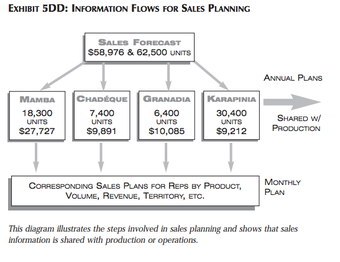
Information Flows for Sales Planning
Sales Planning
Specific steps or stages in a sales process vary from company to company but generally include the following elements:
- Initial contact
- Application of Initial Fit Criteria
- Sales lead
- Need identification
- Qualified prospect
- Proposal
- Negotiation
- Closing
- After sales service
An alternate but similar series of steps is as follows:
- Prospecting/Initial contact
- Preapproach—planning the sale
- Approach
- Need assessment
- Presentation
- Meeting objections
- Gaining commitment
- Follow-up
These eight steps of the sales process are more current and accurate than traditional sales. These are the typical steps taken, which are usually performed in the same order—however, this can vary depending on the current situation. These steps of the sales process are given (pg. 66) and explained in one of the most influential sales textbooks written by Gregory A. Rich, Rosann L. Spiro, and William J Stanton, entitled “Management of a Sales Force” Twelfth Edition.
Mapping a process provides a starting point for further careful analysis and continuous improvement. Diagramming a process flow is considered to be one of the seven basic quality improvement tools. Elements in the list above (among many others) have been described and flow-charted in the published literature. Some examples have primarily focused on functions performed by a sales “department”. At least one cross-functional approach depicts and integrates a variety of interdependent areas, such as sales, marketing, customer service, and information systems.
From a seller’s point of view, a sales process mitigates risk by stage-gating deals based on collection of information or execution of procedures that gate movement to the next step. Of the large number of initially interested persons on the narrow end of orders, only a fraction of the initially interested people remain and actually place an order. This controls seller resource expenditure on non-performing deals. Ideally this also prevents buyers from purchasing products they don’t need, though such a benefit requires ethical intentions by the seller. Because of the uncertainty of this assurance, buyers often have a buying or purchasing process. The interface between the selling and buying processes has also been diagrammed.
A formalized sales process is generally more common for companies that either have complex sales cycles, large revenue risks that require systematic assurance of revenue generation, and/or those that choose to use a more consultative sales approach (e.g. Saturn, IBM, Hewlett-Packard).
An effective sales process can be described through steps that walk a salesperson from meeting the prospect all the way through closing the sale. Often a bad sales experience can be analyzed and shown to have skipped key steps. This is where a good sales process mitigates risk for both buyer and seller. A solid sales process also has the dramatic impact of forecasting accuracy and predictability in revenue results.
Many companies develop their own sales process; however, off-the-shelf versions are available from a number of companies in the sales performance improvement industry. A large number of these methods have been described by their promoters in books available to the public, primarily addressing tactics employed by an individual sales representative. These provide a customizable process and a set of electronic tools that can be freestanding or integrated with the company’s SFA, CRM, or other opportunity management system.
17.4: Advertising
17.4.1: Social and Legal Considerations
Businesses need to understand the legal ramifications and social implications that occur from intentionally misleading the public.
Learning Objective
Explain how false advertising is prevented
Key Points
- False advertising or deceptive advertising is the use of false or misleading statements in advertising.
- Advertising is regulated by the authority of the Federal Trade Commission, a United States administrative agency, to prohibit “unfair and deceptive acts or practices in commerce”.
- The goal is prevention rather than punishment, reflecting the purpose of civil law in setting things right rather than that of criminal law.
Key Term
- Federal Trade Commission
-
The Federal Trade Commission (FTC) is an independent agency of the United States government, established in 1914 by the Federal Trade Commission Act. Its principal mission is the promotion of consumer protection and the elimination and prevention of anti-competitive business practices, such as coercive monopoly.
When crafting advertising and marketing communications, businesses need to understand the legal ramifications of false advertising as well as the social implications that occur from intentionally misleading the public.
False advertising or deceptive advertising is the use of false or misleading statements in advertising. As advertising has the potential to persuade people into commercial transactions that they might otherwise avoid, many governments around the world use regulations to control false, deceptive or misleading advertising. “Truth” refers to essentially the same concept, that customers have the right to know what they are buying, and that all necessary information should be on the label .
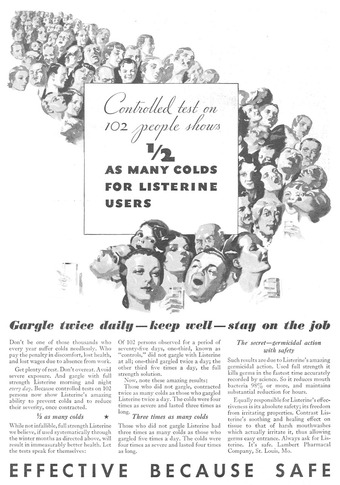
Listerine advertisement, 1932
From 1921 until the mid-1970s, Listerine was also marketed as a preventive and remedy for colds and sore throats. In 1976, the Federal Trade Commission ruled that these claims were misleading, and that Listerine had “no efficacy” at either preventing or alleviating the symptoms of sore throats and colds. Warner-Lambert was ordered to stop making the claims, and to include in the next $10.2 million dollars’ of Listerine ads specific mention that “contrary to prior advertising, Listerine will not help prevent colds or sore throats or lessen their severity. “
Advertising is regulated by the authority of the Federal Trade Commission, a United States administrative agency, to prohibit “unfair and deceptive acts or practices in commerce. ” While it makes laymen’s sense to assume that being deceptive is being unfair, deceptiveness in practice has been treated separately by the FTC, leaving unfairness to refer only to other types. All commercial acts may be deceptive, not just advertising, but noncommercial activity such as advertising for political candidates is not subject to prosecution under the FTC Act.
The goal is prevention rather than punishment, reflecting the purpose of civil law in setting things right rather than that of criminal law. The typical sanction is to order the advertiser to stop its illegal acts, or to include disclosure of additional information that serves to avoid the chance of deception. Corrective advertising may be mandated, but there are no fines or prison time except for the infrequent instances when an advertiser refuses to stop despite being ordered to do so. The actual statute defines false advertising as a “means of advertisement other than labeling, which is misleading in a material respect; and in determining whether an advertisement is misleading, there shall be taken into account (among other things) not only representations made or suggested by statement, word, design, device, sound, or any combination thereof, but also the extent to which the advertisement fails to reveal facts material in the light of such representations or material with respect to consequences which may result from the use of the commodity to which the advertisement relates under the conditions prescribed in said advertisement, or under such conditions as are customary or usual. “
In addition to federal laws, each state has its own unfair competition law to prohibit false and misleading advertising. In California, one such statute is the Unfair Competition Law [hereinafter “UCL”], Business and Professions Code § 17200 et seq. The UCL “borrows heavily from section 5 of the Federal Trade Commission Act” but has developed its own body of case law.
17.4.2: Types of Advertising
There are many types of advertising; each has different attributes, such as price, viewing demographic, and medium.
Learning Objective
Classify the various types of marketing and advertising
Key Points
- The TV commercial is generally considered the most effective mass-market advertising format, as is reflected by the high prices TV networks charge for commercial airtime during popular TV events.
- Radio advertising is a form of advertising via the medium of radio.
- Online advertising is a form of promotion that uses the Internet and World Wide Web for the expressed purpose of delivering marketing messages to attract customers.
- Press advertising describes advertising in a printed medium such as a newspaper, magazine, or trade journal.
Key Term
- World Wide Web
-
Collectively, all of the web pages on the Internet which hyperlink to each other and to other kinds of documents and media.
Example
- For example, following his performance of eight gold medals at the 2008 Olympic Games in Beijing, China, swimmer Michael Phelps’ contract with Kellogg’s was terminated, as Kellogg’s did not want to associate with him after he was photographed smoking marijuana. Celebrities such as Britney Spears have advertised for multiple products including Pepsi, Candies from Kohl’s, Twister, NASCAR, Toyota and many more.
There are many types of advertising; each has different attributes, such as price, viewing demographic, and medium.
The TV commercial is generally considered the most effective mass-market advertising format, as is reflected by the high prices TV networks charge for commercial airtime during popular TV events. The annual Super Bowl football game in the United States is known as the most prominent advertising event on television. The average cost of a single thirty-second TV spot during this game has reached $3.5 million (as of 2012).
Radio advertising is a form of advertising that is broadcast as radio waves through the air from a transmitter to an antenna and then to a receiving device. Airtime is purchased from a station or network in exchange for airing the commercials .

Billboard
Clarkes on Belmont billboard
Online advertising is a form of promotion that uses the Internet and World Wide Web for the expressed purpose of delivering marketing messages to attract customers. Online ads are delivered by an ad server. Examples of online advertising include:
- Contextual ads that appear on search engine results pages
- Banner ads
- In-text ads
- Rich Media Ads
- Social network advertising
- Online classified advertising
- Advertising networks
- E-mail marketing, including e-mail spam
Covert advertising, also known as guerrilla advertising, is when a product or brand is embedded in entertainment and media.
Press advertising describes advertising in a printed medium such as a newspaper, magazine, or trade journal. This encompasses everything from media with a very broad readership base, such as a major national newspaper or magazine, to more narrowly targeted media such as local newspapers and trade journals on very specialized topics.
Mobile billboards are generally vehicle mounted billboards or digital screens. These can be on dedicated vehicles built solely for carrying advertisements along routes preselected by clients, they can also be specially equipped cargo trucks or, in some cases, large banners strewn from planes. The billboards are often lighted; some being backlit, and others employing spotlights.
In-store advertising is any advertisement placed in a retail store. It includes placement of a product in visible locations in a store, such as at eye level, at the ends of aisles and near checkout counters (aka POP—Point Of Purchase display), eye-catching displays promoting a specific product, and advertisements in such places as shopping carts and in-store video displays.
Street advertising first came to prominence in the UK by Street Advertising Services to create outdoor advertising on street furniture and pavements. Working with products such as Reverse Graffiti, air dancers, and 3D pavement advertising, the media became an affordable and effective tool for getting brand messages out into public spaces.
Outdoor advertising opens the possibility of combining outdoor with indoor advertisement by placing large mobile, structures (tents) in public places on temporary bases. The large outer advertising space exerts a strong pull on the observer while the product is promoted indoors, where the creative decor can intensify the impression.
Celebrity branding focuses upon using celebrity power, fame, money, or popularity to gain recognition for their products or promote specific stores. Advertisers often advertise their products, for example, when celebrities share their favorite products or wear clothes by specific brands or designers. Celebrities are often involved in advertising campaigns such as television or print ads to advertise specific or general products. The use of celebrities to endorse a brand can have its downsides, however. One mistake by a celebrity can be detrimental to the public relations of a brand.
Sales promotions are another way to advertise. Sales promotions are double purposed because they are used to gather information about what type of customers you draw in and where they are, as well as to jumpstart sales. Sales promotions include things like contests and games, sweepstakes, product giveaways, samples coupons, loyalty programs, and discounts. The ultimate goal of sales promotions is to stimulate potential customers to take action.
17.4.3: Trends in Advertising
With the advent of the ad server, marketing through Internet opened new frontiers for advertisers with the “dot-com” boom of the 1990s.
Learning Objective
Compare guerrilla marketing and niche marketing
Key Points
- The share of advertising spending relative to GDP has changed little across large changes in media.
- At the turn of the 21st century, a number of websites, including the search engine Google, started a change in online advertising by emphasizing contextually relevant, unobtrusive ads intended to help, rather than inundate, users.
- A recent advertising innovation is “guerrilla marketing”, which involves unusual approaches, giveaways of products such as cars that are covered with brand messages, and interactive advertising where the viewer can respond to become part of the advertising message.
Key Terms
- GDP
-
Gross Domestic Product (Economics). A measure of the economic production of a particular territory in financial capital terms over a specific time period.
- advertising
-
communication whose purpose is to influence potential customers about products and services.
With the advent of the ad server, marketing through the Internet opened new frontiers for advertisers and contributed to the “dot-com” boom of the 1990s. Entire corporations operated solely on advertising revenue, offering everything from coupons to free Internet access. At the turn of the 21st century, a number of websites, including the search engine Google, started a change in online advertising by emphasizing contextually relevant, unobtrusive ads intended to help, rather than inundate, users. This has led to a plethora of similar efforts and an increasing trend of interactive advertising.
The share of advertising spending relative to GDP has changed little across large changes in media. For example, in the US in 1925, the main advertising media were newspapers, magazines, signs on streetcars, and outdoor posters. Advertising spending as a share of GDP was about 2.9 percent. By 1998, television and radio had become major advertising media. Nonetheless, advertising spending as a share of GDP was slightly lower—about 2.4 percent.
Guerilla Marketing
A recent advertising innovation is “guerrilla marketing”, which involves unusual approaches such as staged encounters in public places, giveaways of products such as cars that are covered with brand messages, and interactive advertising where the viewer can respond to or become part of the advertising message. Guerrilla advertising is becoming increasingly popular with more companies. This type of advertising is unpredictable and innovative, which causes consumers to buy the product or idea. This reflects an increasing trend of interactive and “embedded” ads, such as via product placement, having consumers vote through text messages, and various innovations utilizing social network services such as Facebook .

Candidate for Congress
Walter Faulkner, candidate for U.S. Congress, campaigning with a Tennessee farmer. Crossville, Tennessee.
Niche Marketing
Another significant trend regarding future of advertising is the growing importance of the niche market using niche—or targeted—ads. Also brought about by the Internet and the theory of The Long Tail, advertisers will have an increasing ability to reach specific audiences. In the past, the most efficient way to deliver a message was to blanket the largest mass market audience possible. However, usage tracking, customer profiles and the growing popularity of niche content brought about by everything from blogs to social networking sites, provides advertisers with audiences that are smaller but much better defined. This leads to ads that are more relevant to viewers and more effective for companies’ marketing campaigns. Among others, Comcast Spotlight is one such advertiser employing this method in their video on demand menus. These advertisements are targeted to a specific group and can be viewed by anyone wishing to find out more about a particular business or practice at any time, right from their home. This causes the viewer to become proactive and actually choose what advertisements they want to view.
With the Internet came many new advertising opportunities: popup, Flash, banner, popunder, advergaming, and email advertisements (all of which are often unwanted or spam in the case of email) are now commonplace. Particularly since the rise of “entertaining” advertising, some people may like an advertisement enough to wish to watch it later or show a friend. In general, the advertising community has not yet made this easy, although some have used the Internet to widely distribute their ads to anyone willing to see or hear them. In the last three quarters of 2009 mobile and internet advertising grew by 18.1% and 9.2% respectively. Older media advertising saw declines: −10.1% (TV), −11.7% (radio), −14.8% (magazines) and −18.7% (newspapers ).

Advertising
Advertisers will have an increasing ability to reach specific audiences due to changes in digital technology.
17.4.4: Agencies
An advertising agency or advert agency is a service business dedicated to creating, planning, and handling advertising for its clients.
Learning Objective
Explain advertising agencies’ role in communicating ideas
Key Points
- Creative agencies specialize in creative or design-based business models; their basic interest is in the creation of the advertisement or branding.
- The client who chooses to use a design-only advertising agency must assume some of the advertising purchasing.
- There are agencies that specialize in particular kinds of advertising: recruitment, help-wanted, medical, classified, industrial, financial, direct-response, retail, yellow pages, theatrical/entertainment, investment, travel, and so on.
Key Terms
- investment
-
A placement of capital in expectation of deriving income or profit from its use.
- Ad agencies
-
A service business dedicated to creating, planning, and handling advertising (and sometimes other forms of promotion) for its clients.
An advertising agency or advert agency is a service business dedicated to creating, planning, and handling advertising (and sometimes other forms of promotion ) for its clients. An ad agency is independent from the client and provides an outside point of view to the effort of selling the client’s products or services. An agency can also handle overall marketing and branding strategies and sales promotions for its clients.
Ad agencies come in all sizes and include everything from one or two-person shops (which rely mostly on freelance talent to perform most functions), small- to medium-sized agencies such as Traction (agency), large independents such as SMART, and multi-national, multi-agency conglomerates such as Omnicom Group, WPP Group, Publicis, Interpublic Group of Companies, and Havas.

Advertising
Advertisers will have an increasing ability to reach specific audiences due to changes in digital technology.
Creative agencies specialize in creative or design-based business models; their basic interest is in the creation of the advertisement or branding. Other (“full-service”) agencies offer design in conjunction with media buying. Media agencies concentrate on media buying. In the 1990s, media and creative were often unbundled in the interests of economies of scale in buying media.
The client who chooses to use a design-only advertising agency must assume some of the advertising purchasing. These are activities that are routinely handled by an agency with a media buying option. Media buying agencies are sometimes a good choice for larger businesses. These agencies can assume greater responsibility for the strategic planning and function of an advertising campaign. The advantage to a design-only agency is there is no third-party ordering the service. In turn, cost can be lower and is sometimes a good alternative for smaller businesses.
In addition to the full-service, general-line advertising agencies, there are also agencies that specialize in particular kinds of advertising: recruitment, help-wanted, medical, classified, industrial, financial, direct-response, retail, yellow pages, theatrical/entertainment, investment, travel, and so on.
Specialization occurs in such fields for a variety of reasons. Often, as in recruitment advertising, for example, specialized media or media uses are involved that require knowledge and expertise not ordinarily found in a general-line agency. In other cases, such as medical or industrial advertising, the subject is technical and requires that writers and artists have training in order to write meaningful advertising messages about it.
Such specialist advertising agencies are also usually full-service, in that they offer all of the basic advertising agency services in their area of specialization plus other, peripheral advertising services related to their area of specialization.
Some advertisers believe that they can provide these advertising services to themselves at a lower cost than would be charged by an outside agency. An In-House agency is a team that focuses on one goal to sell the company’s product; they will handle all aspects of the brand. In-House is the better option if a company is looking to build up an image over a number of years and create continuity between all aspects of separate campaigns.
Due to the social networking explosion, new types of companies are doing reputation management. This type of agency is especially important if a company needs online damage control. For example, disgruntled customers can quickly and easily damage a company’s reputation via social networking sites. Reputation management companies help stem the negative information or misinformation that might proliferate in their absence.
Social media agencies specialize in promotion of brands in various social media platforms like blogs, social networking sites, Q&A sites, discussion forums, microblogs etc. The two key services of social media agencies are social media marketing and online reputation management.
While not advertising agencies, enterprise technology agencies often work in tandem with advertising agencies to provide a specialized subset of services offered by some interactive agencies, such as Web 2.0 website design and development, content management systems, web application development, and other intuitive technology solutions for the web, mobile devices, and emerging digital platforms. The student-run advertising agency model, which mainly operates out of university classrooms or as a student groups, provides free advertising services to clients in exchange for the educational opportunity.
